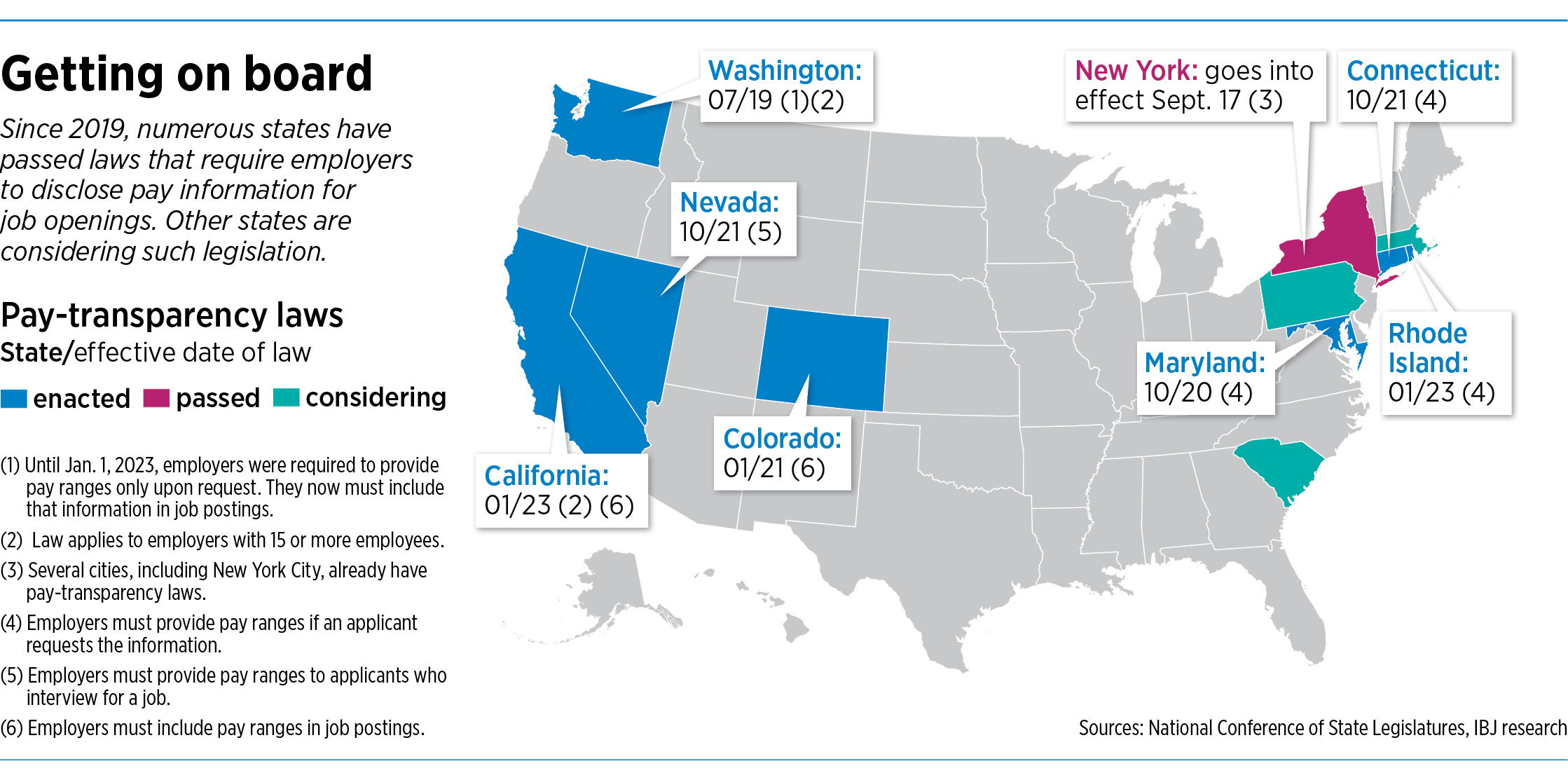Subscriber Benefit
As a subscriber you can listen to articles at work, in the car, or while you work out. Subscribe NowCompensation has long been a taboo topic around most watercoolers, but that’s changing as more states are forcing companies to open up about their salaries.
And while most of the pay-transparency laws adopted the past few years are in states closer to the East and West coasts, some employers in Indiana are impacted, too, even though no such law is on the books here and none appears to be on the horizon.
On Jan. 1, California and Rhode Island became the latest states to mandate pay transparency, joining Colorado, Connecticut, Maryland, Nevada and Washington. New York’s law goes into effect Sept. 17, and at least three other states’ legislatures are considering their own proposals. A handful of municipalities, including New York City, have also adopted pay-transparency laws.
The laws have emerged as a hot topic of conversation among Hoosier employers who recruit from (or have existing employees in) one of those places.
“I’m getting lots of questions from tech and other industries, too: ‘How do we deal with it?’” said Megan Nail, vice president at insurance broker and consulting firm NFP Corp.’s total rewards practice. Nail works from NFP’s Indianapolis office, which was established when the New York City-based company acquired First Person Inc. in 2021.
Nail, who specializes in compensation consulting, said most of her Indiana-based clients are tackling pay transparency as one of their first-quarter priority projects.
Each state’s law is different, but in general they all require some degree of pay-range disclosure for employers with job openings.
In California, Colorado and Washington, employers must include salary information in job postings. In Connecticut, Maryland and Rhode Island, employers must provide the information if an applicant asks for it. In Nevada, employers must provide the information once an applicant has had an interview.
And in some states, employers must provide pay-range information not just to potential employees but also to a current employee who requests it.
“The underlying purpose of these laws is to create pay equity,” said attorney Charles Bush II, a partner at Indianapolis-based law firm Ice Miller LLP.
And it’s an issue Bush said isn’t likely to fade away. “I think it will gain traction among more and more states.”
Natalie Engledow, a partner at Carmel-based consulting firm Purpose HQ, has a similar view.
Because it can be a way to reduce pay disparities, transparency can promote diversity, equity and inclusion, Engledow said. Being transparent about pay can also build employees’ trust, and job ads that include salary information can also attract more attention from job seekers, she said.
“There’s a long list of reasons why this is such a hot topic right now,” she said.
Bush’s clients include companies both inside and outside Indiana in industries such as manufacturing and health care. Some of those clients have employees in multiple states and are trying to navigate the emerging pay-transparency landscape, he said. “They’re asking how to comply with these laws.”
Compliance can be complicated, Bush said, because of the differences from state to state. “These laws, they vary. Colorado might be one thing; California might be another. In New York, it might be something else. … You have to know these nuances, or you’re going to open yourself up to potential exposure.”
Complex issue
Hope Williams, director of talent at Indianapolis-based venture studio High Alpha, said she doesn’t think the pay transparency laws will dissuade companies from hiring workers in places like Colorado or California. But she said it is making those companies more aware of the number of states they’re operating in.
High Alpha’s portfolio of software-as-a-service companies includes both firms based in Indiana and those based elsewhere, ranging from tiny startups with a handful of workers to established firms with 100 or more employees. Many of the companies have at least some remote workers.
Williams said the concept of pay transparency was already a trend in the tech industry, but since the start of the year, “we just have way more companies that are affected by it.”
High Alpha has several prelaunch companies—very-early-stage startups that haven’t yet made a public debut—that have already committed to including salary ranges in all their job postings, Williams said. “They, and we, anticipate that this is only going to become more common.”
Some much larger companies have also started posting pay ranges with at least some of their job ads.
San Francisco-based Salesforce Inc., for instance, posted an engineering job this month that lists nine possible locations for the job, including Indianapolis, San Francisco, Denver and the Seattle area. The ad specifies the pay ranges for the job in California, Colorado and Washington—the states on the list in which pay transparency laws exist. No pay ranges are listed for Indiana or the other five states.
Salesforce did not directly answer an IBJ question about why the California, Colorado and Washington pay ranges were the only ones included. A spokesperson said only that the company is “complying with all requirements and regulations.”
Legal compliance aside, sources say the issue of pay transparency involves a lot more than just adding a pay range to a job ad. It also affects a company’s current employees.
What if, for instance, a company’s ad includes a salary range that’s higher than what some existing employees make in the same position? That can raise a host of tricky questions.
Being transparent with pay, Engledow said, “tends to expose some of the inconsistencies in your own organization.”
“And if you’re not prepared for that, that can be pretty tough on your managers.”
Bush said he advises his clients to consider conducting a pay equity study—a look at what employees currently earn and whether there are what he described as “unexplainable pay disparities.”
As an example, if two people hold the same job title but one person has many more years of experience, that could explain why the senior employee has a higher salary. But if a woman or a person of color is making less than a peer with equal experience, Bush said, that difference might be unexplainable.
Companies that discover such disparities, Bush said, can then take steps to address them.
As part of the pay equity study, he said, companies should also come up with pay ranges for existing jobs—not an easy task, he acknowledged.
Becoming more transparent about pay, Engledow said, is something companies should view as a continual process rather than a one-time fix. “It’s something we should be reviewing regularly because it’s certainly something that can change over time.”
The Salesforce spokesperson pointed to the company’s ongoing efforts to address pay disparity. Salesforce began tackling the issue in 2015.
In its most recent pay equity report, issued last March, Salesforce said it performs an equal-pay audit every year, making adjustments as needed. “Early on in our equal pay journey, we learned that you cannot fix it once and move on,” the report said.
In its most recent audit, the company said, it found that 8.5% of its global employees required pay adjustments, with 92% of those cases based on gender and 8% based on race or ethnicity. Salesforce said it spent $5.6 million to address those unexplained pay disparities and has spent more than $22 million total on the effort since 2015.
Tammy Baker, chief operating officer at Indianapolis-based Parker Technology LLC, said her company doesn’t expect to see a huge change as states adopt pay transparency laws. That’s because the company has for years been posting pay information as part of its job postings.
“I find that a lot of people just expect it, period,” Baker said.
Parker Technology sells a two-way video system that allows parking-garage users to connect with a live person who can help with problems such as malfunctioning gate arms or confusing payment instructions. The company has 58 employees—mostly in its Indianapolis and Las Vegas call centers, with a handful of remote employees in places like Ohio and California.
The company has a policy of keeping existing employees’ wages up to par with what new employees are offered, Baker said.
When Baker started at the company in 2015, Parker’s customer service employees were hired at a base starting rate of $8.75 an hour. That rate is now $14, with attendance and productivity bonuses that boost most employees’ hourly pay by several dollars.
As the pay for that position has gone up for new hires, Baker said, so has the pay for existing employees. “I realize that it’s a cost, but it’s well worth it. These are the people that have gotten you where you are, and they deserve that just as a new employee would.”
No action here
It doesn’t appear that Indiana will see pay transparency legislation anytime soon.
A media spokeswoman for Sen. Linda Rogers, a Republican from Granger who chairs the Indiana Senate Pensions and Labor Committee, said she was unaware of any pay transparency legislation in the works.
Likewise, a spokesman for Rep. Heath Van Natter, a Republican from Kokomo who chairs the House Employment, Labor and Pensions Committee, said the lawmaker was unaware of any filed legislation or anyone working on legislation related to pay transparency.
That might not be surprising. So far, pay transparency bills are emerging in states that Democrats control. In Indiana, Republicans have supermajorities in the House and Senate.
Legislators in many states are also likely to wait to see whether the existing laws are tested in court.
“This is still so early on in the legal sphere,” High Alpha’s Williams said. “You haven’t seen many decisions come out about how states want to enforce this.”
So when it comes to navigating pay transparency issues, she said, High Alpha is advising its portfolio companies to “just be cautious and fair, as much as you can.”•
Please enable JavaScript to view this content.





As a recently retired state employee whose salary was available on the Indiana government website and through alternate sources like indystar.com, I can attest more to the problems that can arise with salary transparency. Although it could lead to more pay equity, it also can demoralize staff and produce resentment and jealousy, particularly in organizations like government where salary adjustments may not be easily made.
The ultimate solution: pay parity as an adult version of participation trophies.